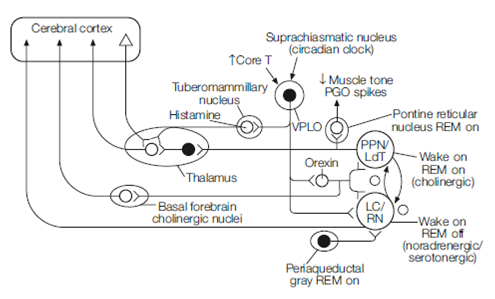Physiology of Nrem sleep
The start of NREM sleep is organized by hypothalamic nuclei and involves suppressing both branches of the ascending reticular formation (Figure 5). GABAergic neurons in the ventrolateral pre-optic area (VLPO) inhibit histaminergic neurons in the tuberomam- millary nucleus. The loss of excitation on thalamic relay neurons causes them to hyper- polarize so they go into burst firing, NREM sleep, and mode. VLPO cells suppress the cortical branch of the ascending reticular formation by inhibiting all the orexigenic and the monoaminergic neurons. Inhibition of the orexin neurons:
- Shuts off the cholinergic basal forebrain cortical arousal system
- Decrease activity of the serotonergic and noradrenergic (wake-on/REM-off) cells and of the pontine cholinergic (wake-on/REM-on) cells
While the loss of activity in the wake-on or REM-off cells lift their inhibition on the pontine cholinergic cells the lack of tonic excitation from the orexin neurons keeps them quiet.
The triggers for NREM sleep, that activate the GABAergic VLPO cells are not well understood but involve the biological clock in the suprachiasmatic nucleus, and elevated core temperature detected through warm receptors in the hypothalamus. The number of molecules has also been proposed as candidate endogenous sleep-producing substances including adenosine, melatonin, and interleukin-1. Adenosine, derived from ATP by neural activity is secreted by astrocytes into the brain extracellular space; an example of gliotransmission. Adenosine concentration rises during wakefulness and it decreases the activity of the cholinergic cells of the basal forebrain cortical arousal system by acting at adenosine A1 receptors. During sleep, adenosine concentrations decrease as it is degraded through adenosine deaminase.

Figure 5. A model for the neural circuitry regulating sleep and wakefulness. LC/RN, locus coeruleus/Raphe nuclei; PPT/LdT, pedunculopontine nucleus/lateral dorsal tegmental nucleus; VLPO, ventral lateral pre-optic hypothalamus. Open circles, excitatory neurons; filled circles, GABAergic inhibitory neurons.